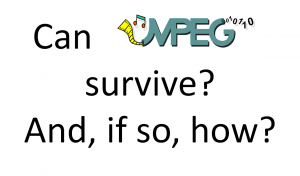Introduction
There have always been people in need of technology and, most of the time, people ready to provide something in response to the demand. In book XVIII of Iliad, Thetis, Achilles’s mother, asks Hephestus, the god of, blacksmiths, craftsmen, artisans, sculptors and more, to provide a new armour to her son who had lost it to Hector. Hephestus duly complied. Still in the fictional domain, but in more recent years, Agent 007 visits Q Branch to get the latest gadgets for his next spy mission, which are inevitably put to good use in the mission.
Wars have always been times when the need for technologies stretches the ability to supply them. In our, supposedly peaceful, age, there are lots of technology around, but it is often difficult for companies needing a particular technology to find the solution matching their needs and budget.
Supply and demand in standardisation
Standardisation is an interesting case of an entity, typically non-commercial and non-governmental, needing technologies to make a standard. Often standards organisations, too, need technologies to accomplish their mission. How can they access the needed technologies?
A few decades back, if industry needed a standard for, say, a video cassette recorder, the process was definitely supply-driven: a company who had developed a successful product (call it Sony or JVC) submitted a proposal (call it Betamax or VHS) to a standards committee (call it IEC SC 60B). Too bad if the process produced two standards.
In the second half of the 1980’s, ITU SG XV (ITU numbering of that time) started developing the H.261 recommendation. Experts developed the standard piece by piece in the committee (so-called Okubo group) by acquiring the necessary technologies in a process where the roles of demand and supply were rather blurred. Only participants were entitled to provide their technologies to fulfill the needs of the standard.
A handful of years later, MPEG further innovated technology procurement in a standardisation environment. To get the technologies needed to make a standard, it used a demand-driven tool – MPEG’s Call for Proposals (CfP). Since then, technologies provided by respondents and assessed for relevance by the group are used to 1) create the initial reference model (RM0) and 2) initiate a first round of Core Experiments (CE). CEs result from the agreement among participating experts that there is room for improving the performance of the standard under development by opening a particular area to optimisation. CEs are continued until available room for optimisation is exhausted. While anybody is entitled to respond to a CfP and contribute technology to RM0, only experts participating in the standardisation project can provide technology for CEs. This, however, is not really a limitation because the process is open to anybody wishing to join a recognised standards organisation who is a member of ISO.
The MPEG process of standards development has allowed the industry to maintain a sustained development and expansion for many years. In fairness, this is not entirely MPEG’s merit. Patent pools have played a synergistic role to MPEG’s by providing (industry) users with the means to practice MPEG standards and IP holders the means to be remunerated for the use of their IP.
The situation today
The HEVC case has shown that the cooperation of different parties to achieve the common goal of enabling the use of a standard is not discounted (see, e.g., A crisis, the causes and a solution). There are several reasons for this: the increasing number of individual technologies needed to make a high-performance MPEG standard, the increasing number of IP holders, the increasing number of Non-Performing Entities (NPE) as providers of technology and the increasing number of patent pools who stand as independent licence providers of a portion of a patent.
I have already made several proposals with the intention of helping MPEG from this stalemate (see, e.g., Business model based ISO/IEC standards). Here I would like to present an additional idea that extends the MPEG process of standards development (see How does MPEG actually work?).
A new process proposal
A possible implementation of the proposal applying to an entity (a company, an industry forum or a standards organisation) wishing to develop a specification or a standard, could run like this (some details could be fine tuned or changed on a case-by-case basis):
- An entity (a company, an industry forum or a standards organisation) wishes to develop a specification or a standard
- The entity issues a Call for Proposals (CfP) including requirements requesting proponents to to accept the process (as defined in this numbered list) and to commit to RAND licensing of their technologies for the specification or standard
- The entity assesses the proposals received
- The entity sets aside a certain amount of tokens for the entire standard (e.g. 1,000)
- The entity builds a “minimal” Reference Model zero (RM0) using technologies contained in the proposals in a conservative way so as to create ample space for a healthy Core Experiment (CE) process
- The entity
- Assigns a percentage of tokens to RM0
- Establishes the amount of tokens that will be given to the proponent who achieves the highest performance in a CE (e.g. 1 token for each 0.1% improvements)
- The entity identifies and publishes CEs at the pace required by the specification or standard
- For each CE the entity makes a call containing
- A description of the CE
- A minimum performance target (say, at least 1% improvement)
- A deadline for submission of 1) results and 2) code that proves that the target has been achieved
- The maximum level of associated complexity
- CE proponents should do due diligence and
- Make proposals that contain only their own technologies, or
- Ask any third party to join in the response (ad accept the conditions of the CfP)
- If the tokens are all used and there is still room for optimisation, new tokens are created and token holders have their tokens scaled down so that the total number of tokens is still 1,000
- If room for RM optimisation is exhausted but there are still tokens unassigned, token holders have their tokens scaled up so that the total number of tokens is 1,000.
Depending on the nature of the entity (company-industry forum-standards organisation) another entity, which can be the same entity who has managed the process or a patent pool
- Identifies who are IP holders in RM0 and CEs
- Removes technology in case the status of IP has not been clarified
- After completing steps 1 and 2, pays royalties to IP holders based on the number of tokens they have acquired in the process (i.e. RM0 and CEs)
Merits and limits of the proposal
The proposal achieves the goal to
- Associate patent holders to RM0 and CE areas as opposed to associate patent holders just to the standard
- Enablthe turning off of technologies of a CE area if this has unclear IP status and turning them on again if the status is clarified
In case the entity developing the specification is a standards organisation, more than one patent pool can develop a licence using the results of the process.
Conclusions
This idea was developed in collaboration with Malvika Rao, the founder of Incentives Research and holder of a PhD from Harvard University, and Don Marti, an open source expert and an advisor at Incentives Research.
Converting the basic concept described above into a workable market design requires further work. There may be opportunities to game the system, and the design must consider issues such as how to attract and retain participation. In addition the design must be tested (e.g., via simulation or usability study) to understand its performance.
Please send comments to Leonardo.
Posts in this thread
- Matching technology supply with demand
- What would MPEG be without Systems?
- MPEG: what it did, is doing, will do
- The MPEG drive to immersive visual experiences
- There is more to say about MPEG standards
- Moving intelligence around
- More standards – more successes – more failures
- Thirty years of audio coding and counting
- Is there a logic in MPEG standards?
- Forty years of video coding and counting
- The MPEG ecosystem
- Why is MPEG successful?
- MPEG can also be green
- The life of an MPEG standard
- Genome is digital, and can be compressed
- Compression standards and quality go hand in hand
- Digging deeper in the MPEG work
- MPEG communicates
- How does MPEG actually work?
- Life inside MPEG
- Data Compression Technologies – A FAQ
- It worked twice and will work again
- Compression standards for the data industries
- 30 years of MPEG, and counting?
- The MPEG machine is ready to start (again)
- IP counting or revenue counting?
- Business model based ISO/IEC standards
- Can MPEG overcome its Video “crisis”?
- A crisis, the causes and a solution
- Compression – the technology for the digital age
- On my Charles F. Jenkins Lifetime Achievement Award
- Standards for the present and the future


